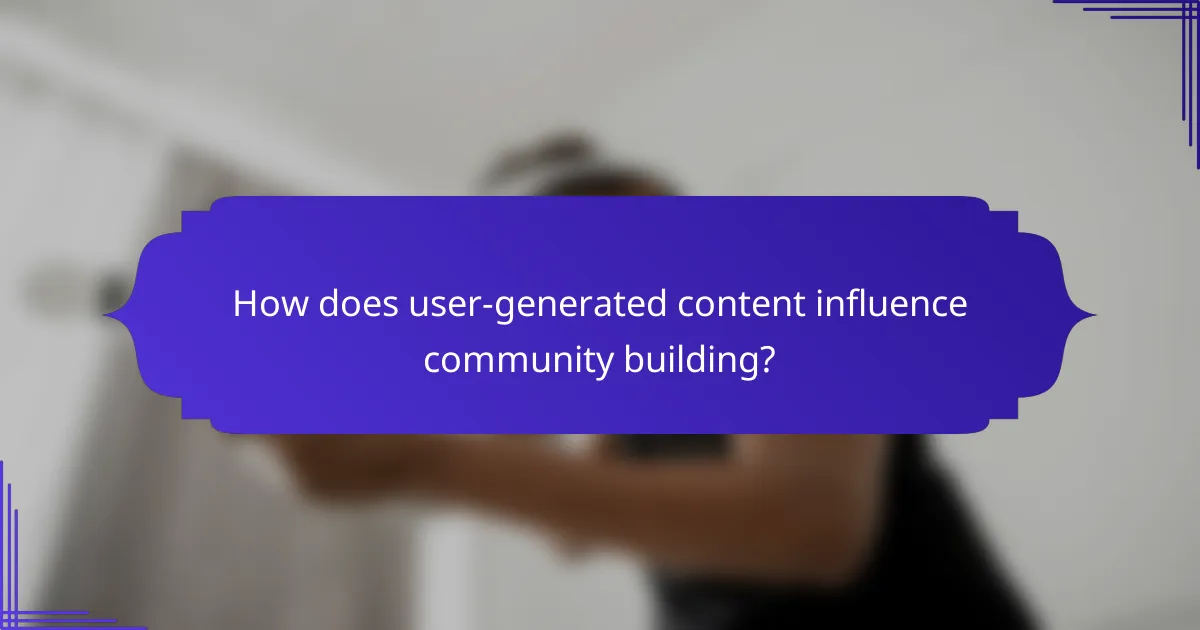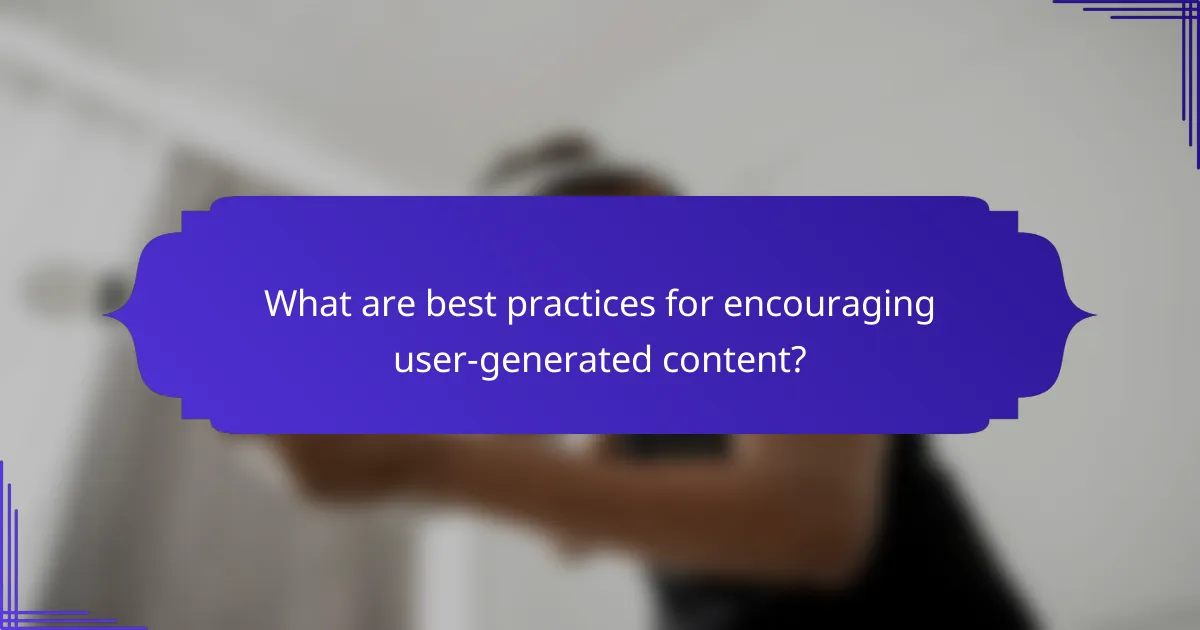User-generated content drives community engagement and enhances brand narratives. It fosters participation, allowing users to share their stories and experiences. Effective strategies can build loyalty and create a vibrant community atmosphere. However, challenges such as quality control and brand alignment must be managed to maximize impact.

How does user-generated content influence community building?
User-generated content significantly enhances community building by fostering engagement and creating shared narratives. This content encourages participation, allowing users to express their experiences and opinions. As a result, communities become more cohesive and interactive.
User-generated content also expands storytelling opportunities. It allows diverse voices to contribute, enriching the narrative landscape. This inclusion creates a sense of belonging and investment among community members.
Furthermore, engagement strategies leveraging user-generated content can boost loyalty. When users see their contributions valued, they are more likely to remain active participants. This leads to a vibrant, dynamic community atmosphere.
Overall, user-generated content serves as a catalyst for community growth, enhancing connection, narrative depth, and engagement.
What role does authenticity play in user-generated content?
Authenticity significantly enhances user-generated content by fostering trust and engagement. When users perceive content as genuine, they are more likely to connect emotionally and share it within their networks. This organic sharing amplifies community impact, as authentic stories resonate more deeply with audiences. Furthermore, authenticity encourages diverse perspectives, enriching the narrative and expanding its reach. As a result, brands leveraging authentic user-generated content often see increased loyalty and interaction from their communities.
How can user-generated content foster a sense of belonging?
User-generated content fosters a sense of belonging by creating shared experiences and connections among community members. This type of content encourages individuals to express themselves, share their stories, and engage with others who have similar interests or values. By showcasing diverse perspectives, user-generated content enhances community identity and promotes inclusivity. As a result, participants feel valued and recognized, strengthening their emotional ties to the community.

What strategies enhance story expansion through user-generated content?
User-generated content enhances story expansion by fostering community engagement and collaboration. Strategies include encouraging storytelling through prompts, showcasing user contributions prominently, and creating feedback loops for continuous interaction. These methods build a sense of belonging and investment among users, leading to richer narratives and broader reach. Engaging users in this way leverages their unique experiences, transforming them into brand advocates.
Which platforms are most effective for sharing user-generated stories?
Social media platforms, especially Instagram, Facebook, and TikTok, are most effective for sharing user-generated stories. These platforms prioritise visual content and community engagement, fostering connections among users. Instagram’s features like Stories and Reels enhance storytelling through visuals and short videos. Facebook groups facilitate community discussions and sharing of experiences. TikTok’s algorithm promotes viral content, amplifying user stories to wider audiences. Each platform’s unique attributes support diverse storytelling methods, maximizing reach and engagement.
How do storytelling techniques vary across different cultures?
Storytelling techniques differ significantly across cultures, influenced by values, traditions, and social norms. For instance, Western narratives often emphasise individualism, while Eastern cultures may focus on collectivism and harmony. Additionally, oral traditions play a vital role in many Indigenous cultures, fostering community bonds and preserving history. These variations shape user-generated content, enhancing community impact and engagement strategies by reflecting diverse perspectives and experiences.

Why is engagement critical for user-generated content success?
Engagement is critical for user-generated content success because it fosters community interaction and enhances content visibility. Active participation encourages users to share their experiences, creating a sense of belonging. This interaction leads to richer narratives and diverse perspectives, amplifying the overall impact of the content. Engaged users are more likely to contribute quality content, driving organic growth and increasing brand loyalty.
What metrics should be used to measure engagement levels?
To measure engagement levels of user-generated content, utilise metrics such as interaction rates, content shares, comments, and user retention. These metrics provide insights into community impact and the effectiveness of engagement strategies.
| Metric | Description |
|———————-|————————————————–|
| Interaction Rate | Percentage of users engaging with content |
| Content Shares | Number of times content is shared across platforms|
| Comments | Total user comments indicating active participation|
| User Retention Rate | Percentage of returning users over a specific time frame|
| Reach | Number of unique users exposed to the content |
| Conversion Rate | Percentage of users taking a desired action after engaging|
How can brands leverage user-generated content for higher engagement?
Brands can leverage user-generated content (UGC) to enhance engagement by fostering community connections and expanding brand narratives. UGC builds trust, as consumers often view peer-generated content as more authentic than traditional marketing. Encouraging customers to share their experiences can lead to increased brand loyalty and a sense of belonging within the community.
Engagement strategies include creating campaigns that invite users to submit content, such as photos or testimonials, showcasing their interactions with the brand. This not only amplifies brand visibility but also allows for diverse storytelling that resonates with various audience segments.
Additionally, brands can highlight UGC across their platforms, creating a feedback loop that encourages further participation. By recognising and rewarding contributors, brands can cultivate a vibrant community that continuously generates content, enhancing overall engagement and customer satisfaction.
Incorporating user-generated content can lead to higher conversion rates, as studies show that UGC can increase purchase likelihood by up to 79%. This demonstrates the powerful impact of community-driven content on brand success.

What challenges do organizations face with user-generated content?
Organizations face several challenges with user-generated content, including quality control, brand alignment, and engagement management. Ensuring the authenticity of submissions can be difficult, as poor-quality content may harm brand reputation. Additionally, aligning user contributions with brand messaging requires careful moderation. Managing community engagement is also complex, as organizations must balance user input with their messaging strategy. These challenges can hinder the effective utilization of user-generated content for community impact and story expansion.
How can brands manage negative user-generated content?
Brands can manage negative user-generated content by actively monitoring, responding promptly, and promoting positive interactions. Effective strategies include establishing clear community guidelines, engaging with users empathetically, and leveraging feedback for improvement. By addressing concerns transparently, brands can rebuild trust and enhance community engagement.
What are the legal considerations surrounding user-generated content?
Legal considerations surrounding user-generated content include copyright, liability, and privacy issues. Content creators must understand that they can be held responsible for copyright infringement if they use protected material without permission. Additionally, platforms hosting user-generated content may face liability for harmful or defamatory posts, which necessitates clear community guidelines. Privacy laws also play a crucial role, especially regarding the collection and use of personal data. Understanding these legal aspects is vital for fostering a safe and compliant online community.

How can user-generated content drive marketing strategies?
User-generated content enhances marketing strategies by fostering community engagement, expanding brand narratives, and building trust. This content often reflects authentic customer experiences, which resonate with potential buyers. As a result, brands leveraging user-generated content see increased interaction and loyalty. Additionally, campaigns utilising this content can achieve higher conversion rates, as consumers prefer peer recommendations.
What are the benefits of incorporating user-generated content into campaigns?
Incorporating user-generated content into campaigns boosts authenticity, enhances community engagement, and expands storytelling. This approach fosters trust as consumers relate to real experiences. Additionally, it encourages participation, creating a sense of belonging among users. Brands leveraging this content often see increased loyalty and higher conversion rates.
How can user-generated content enhance brand loyalty?
User-generated content significantly enhances brand loyalty by fostering community engagement and authentic connections. This content allows brands to showcase real customer experiences, creating a sense of belonging among consumers. Engaging with user-generated content builds trust, as potential customers see genuine testimonials and stories. As a result, brands can expand their narratives and resonate more deeply with their audience. Encouraging user participation through campaigns or social media challenges further strengthens these bonds, leading to increased loyalty and advocacy.

What are best practices for encouraging user-generated content?
Encouraging user-generated content involves fostering community involvement, offering incentives, and creating a supportive environment. Start by establishing clear guidelines to ensure contributions align with your brand values. Engage users through social media campaigns that invite them to share their experiences. Highlight user contributions on your platforms to recognise their efforts and build a sense of community. Additionally, provide tools or templates to simplify the content creation process, making it accessible for all users.
How can brands incentivise users to create content?
Brands can incentivise users to create content by offering rewards, fostering community engagement, and showcasing user contributions. Reward systems can include discounts, exclusive products, or recognition on brand platforms. Engaging users through challenges or contests encourages participation and creativity. Highlighting user-generated content on social media or websites enhances visibility and builds a sense of community. These strategies promote deeper connections and loyalty between users and brands.
What common mistakes should brands avoid when utilising user-generated content?
Brands should avoid common mistakes like neglecting proper attribution, failing to engage with contributors, and using content without consent. These errors can harm brand reputation and community trust. Prioritising transparency and collaboration enhances user-generated content’s effectiveness. Brands should also avoid over-editing content, which can dilute authenticity. Lastly, not measuring the impact of user-generated content can lead to missed opportunities for improvement and engagement.
